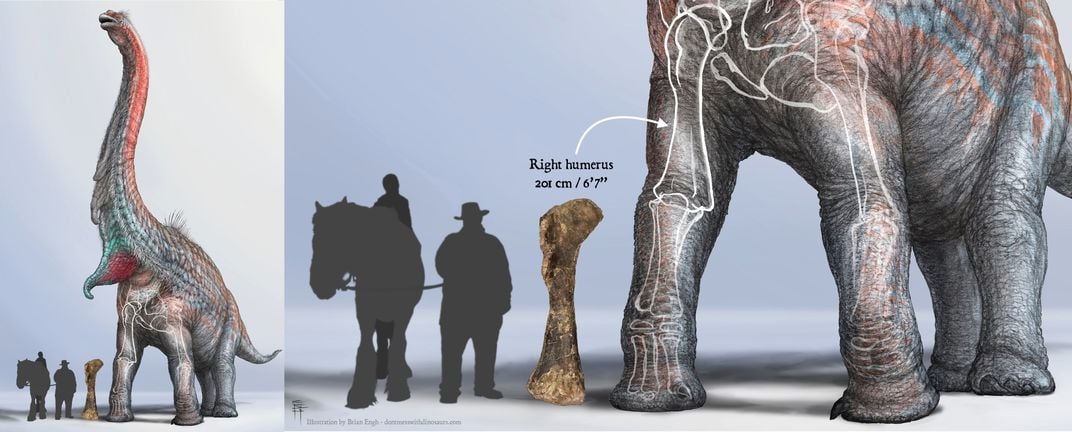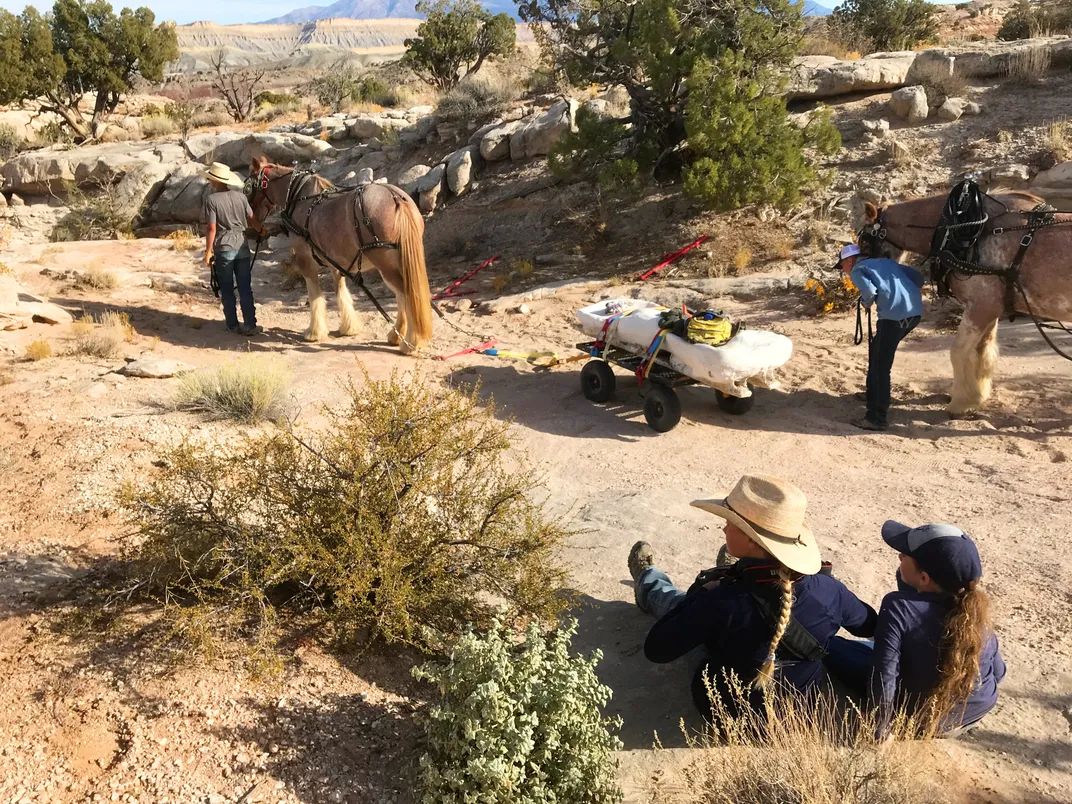A Pair of Horses Helped Excavate a Hulking Brachiosaurus Fossil in Utah
Brachiosaurus remains rarely surface in the fossil record
/https://tf-cmsv2-smithsonianmag-media.s3.amazonaws.com/filer/44/c2/44c24277-b43c-465c-b043-13f56ee36d22/brachiosaurus_jacket_flip.jpg)
Last May, a trio of fossil experts in Utah discovered the hulking humerus of a Brachiosaurus jutting out of the Morrison Formation, a Late Jurassic rock unit that stretches across the western United States. They were thrilled—Brachiosaurus remains rarely appear in the fossil record—but also worried. The humerus “was lying in what looked like loose dirt, actually sitting in a little fan of sediment cascading down into the gulch,” writes paleontologist Matt Wedel in a blog post. “We knew we needed to get it out before the winter rains came and destroyed it.”
The relic was more than six-and-half feet long and, once it had been wrapped in a protective “jacket” and affixed to two pieces of wood, weighed nearly 1,000 pounds, according to Anna Salleh of the Australian Broadcasting Corporation. It was impossible for a car to reach the discovery site, located in a hard-to-access region of the Morrison Formation known as the Salt Wash Member. Airlifting the fossil to a secure place via helicopter would require fundraising, which would in turn require precious time. So Wedel, who discovered the bone along with paleoartist Brian Engh and paleontologist Thuat Tran, and their team came up with a different solution. They enlisted the help of two Clydesdale horses named Molly and Darla to haul the bone out of its prehistoric resting place.

As Sabrina Imbler reports for Atlas Obscura, the humerus is now safely located in the Utah Field House of Natural History State Park Museum, where it is on display. This Brachiosaurus bone is hardly the first fossil to surface in the Morrison Formation; since the quarry was discovered in 1909, it has yielded a wealth of dinosaur remains. One area of the formation has in fact been designated the Dinosaur National Monument, where modern visitors can see dinosaur fossils peeking out from within the rocks. But a Brachiosaurus fossil—that represents a very rare find indeed.
“I’ve been working in the Morrison Formation for 10 years, and I never anticipated we would dig up a Brachiosaurus,” ReBecca Hunt-Foster, park paleontologist for Dinosaur National Monument, who participated in the excavation, tells Atlas Obscura. “I never even thought we’d see one.”
The Brachiosaurus thundered across our planet between 150.8 million and 155.7 million years ago, a soaring sauropod that may have stood more than 40 feet tall. In spite of its formidable presence in the prehistoric world, only ten confirmed Brachiosaurus fossils have been discovered, and none are complete, according to Atlas Obscura. Brachiosaurus humeri, or bones of the upper forelimb, are “exceptionally rare,” explains Wedel. To date, just two have been described, one found in Colorado in 1900, the other excavated in the same state in 1955.
John Foster, curator of collections at the Utah Field House, tells Atlas Obscura that experts aren’t entirely sure why Brachiosaurus remains surface so infrequently in the fossil record. By way of comparison, Morrison Formation has yielded hundreds of fossils belonging to Camarasaurus, Diplodocus, Apatosaurus, and Brontosaurus—all of them similarly large, long-necked herbivores that existed at the same time as Brachiosaurus. It is possible that Brachiosauruses in fact lived in a different location—perhaps in an environment less well-suited to preserving ancient bones—and a select few of their remains washed into the area.

The newly unearthed humerus is in “pretty good condition,” Foster tells Mori Kessler of St. George News. Not far from that bone, experts also found “shattered chunks of the matching left humerus,” notes Wedel.
Though the remains were initially discovered in the spring, it wasn’t until October that the team was ready to implement its extraction plan for the humerus. It was not an easy process. To prevent the fossil from breaking, it had to be wrapped in strips of burlap dipped in plaster of Paris, then hauled onto a wagon so Molly and Darla could drag it away. Some parts of the canyon were unsafe for horses, so the team had to rely on “winches and human power,” Wedel explains. Those stretches, he adds, were “difficult, complex, and terrifying”; things went much more smoothly whenever the horses could chip in.
“The real heroes of the story,” Wedel writes, “are Molly and Darla.”